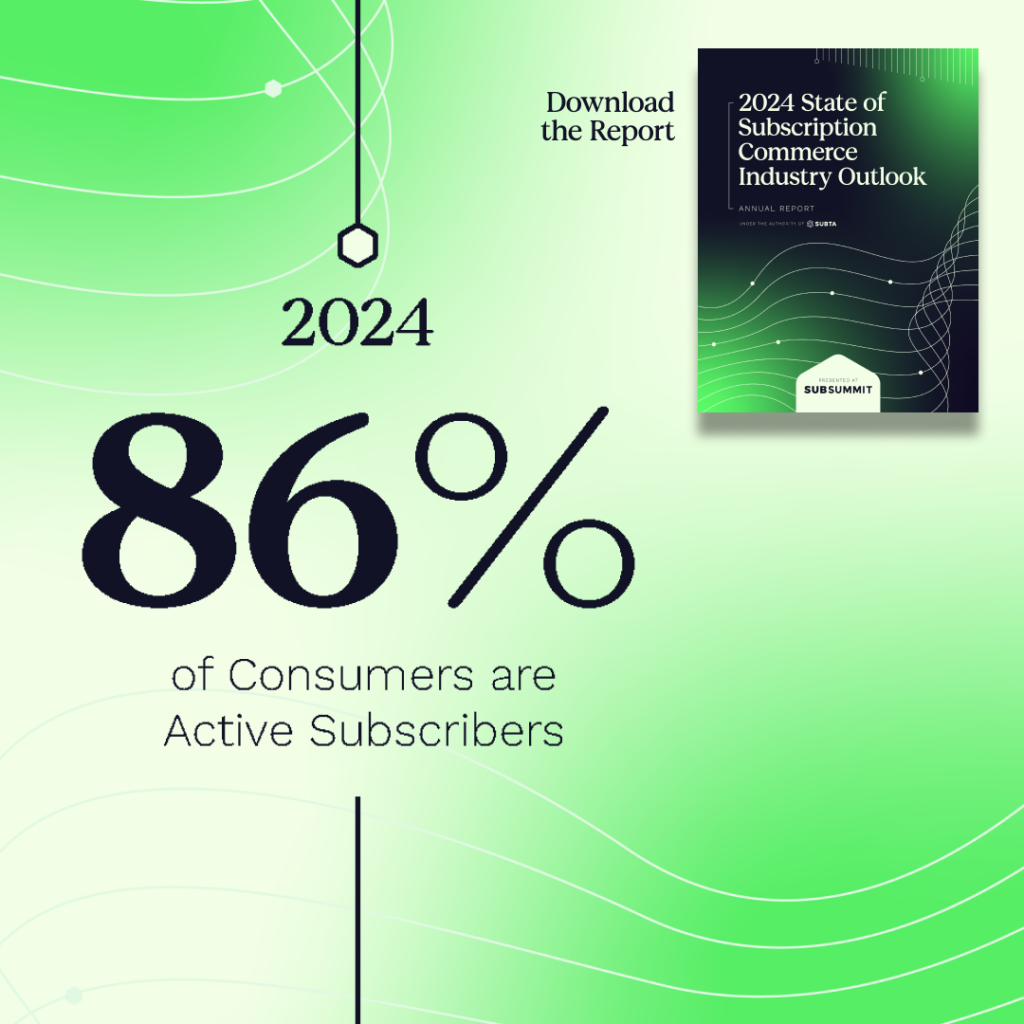
The subscription commerce landscape in 2024 is marked by rapid evolution and increased consumer expectations. As consumers’ needs and behaviors change daily, driven by various factors such as mood, finances, and relationships, businesses must adapt swiftly to stay competitive.
SUBTA’s comprehensive report on the State of Subscription Commerce provides deep insights into current trends, challenges, and future predictions for the industry. Here’s an in-depth recap that delves into the crucial aspects shaping the subscription commerce sector.
Evolving Consumer Behavior in Subscription Commerce
In 2024, consumer behavior in subscription commerce is characterized by a significant shift. Unlike previous years where changes were gradual, the pace of change has accelerated. Consumers now demand more value, faster services, and greater reliability.
The report highlights a notable trend: the number of active subscribers in the U.S. has decreased by 10% year-over-year. However, the majority are still actively engaged with subscription services, indicating that while the market is competitive, there is still substantial opportunity for growth and profit.
Valuation and Segmentation of Subscription Commerce
The subscription, membership, and loyalty sector is booming, with the industry valued at an estimated $3 trillion in 2024, up from $2 trillion in 2023. This growth underscores the significant economic impact of subscription commerce.
The sector is segmented into various categories, including subscription boxes, SaaS, content streaming, and digital subscriptions. The subscription commerce economy alone contributes 40.8% to the overall market, highlighting its importance and potential for future expansion.

Consumer Preferences and Subscription Churn
Understanding why consumers subscribe and why they cancel is vital for businesses in subscription commerce.
The report identifies streaming services, digital subscriptions, and gym memberships as the top categories for both active subscriptions and cancellations. Financial constraints and perceived lack of value are the primary reasons for cancellations. This finding emphasizes the need for businesses to continually demonstrate value to retain subscribers. Notably, 38% of consumers indicated they would remain subscribed if the service was part of a larger group offering, pointing to the effectiveness and potential of bundling strategies.
Effective Marketing and Sales Channels in Subscription Commerce
Marketing and sales strategies play a critical role in subscription commerce. SUBTA’s report highlights social media, email, and TV commercials as the most effective channels across various demographics.
Social media ads and YouTube commercials are particularly influential among younger consumers, while email remains a strong channel for older demographics. Influencer marketing is also on the rise, with 75% of brands using AI for content generation and customer retention strategies.
Personalization based on customer data is key, and AI-driven tools can enhance engagement by tailoring experiences to individual preferences.
The Case for Bundling in Subscription Commerce
Bundling complementary products and services is a growing trend in subscription commerce.
Consumers prefer managing subscriptions in one central hub and favor bundled billing options. Platforms like Verizon’s +play exemplify successful bundling strategies by offering centralized management and exclusive deals. However, implementing bundling can present operational challenges, such as ensuring a seamless user experience and maintaining flexibility for consumers.
Delivering Undeniable Value in Subscription Commerce
Providing exceptional customer experiences from acquisition to retention is paramount to succeeding in the subscription commerce industry.
Brands need to offer personalized and flexible solutions to avoid making customers feel trapped. Successful examples include Chewy’s empathetic customer support and Amazon Prime’s “Try Before You Buy” program, which enhance customer loyalty by delivering value beyond the initial purchase.
Flexibility in subscription management, such as easy cancellation and pause options, is also crucial in retaining customers.

Omnichannel Strategy: The Future of Subscription Commerce in Retail
An omnichannel approach is essential for sparking and nurturing customer loyalty in subscription commerce. Subscription brands are increasingly exploring retail expansions to diversify revenue streams. Case studies like Obvi’s integration into Walmart highlight the benefits and challenges of such strategies.
Effective packaging, competitive pricing, and engaging post-purchase experiences are critical for success in retail channels. Establishing a relationship with customers through omnichannel strategies can drive long-term loyalty and enhance the overall customer experience.
Leveraging AI and Data in Subscription Commerce
AI is transforming subscription commerce by improving customer support and enhancing personalized experiences. Successful implementations include Amazon’s AI features for Thursday Night Football and Wuffes’ AI-driven customer service, which have significantly improved customer engagement and reduced cancellations.
However, the report cautions against over-reliance on third-party data providers. A blend of owned and third-party data is recommended to drive impactful decisions and better understand customer behavior.
Future Outlook for Subscription Commerce
Looking ahead, the focus for direct-to-consumer marketers in subscription commerce should be on customer acquisition, engagement, and retention. Brands need to continually innovate and adapt to consumer preferences, leveraging technology and data to create seamless and valuable customer experiences.
The 2024 report emphasizes the necessity for hyper-focused data collection, effective use of AI, and a robust omnichannel strategy to stay competitive in the evolving market.
Key Takeaways for Subscription Commerce Brands
To thrive in the competitive landscape of subscription commerce, brands must focus on the following key areas:
- Evaluate Your Value Proposition: Clearly communicate your value proposition to new and existing customers. Strive to offer an all-encompassing experience from the moment a prospective customer learns about your company.
- Experiment with Acquisition Channels: Utilize a variety of marketing channels such as emails, TV commercials, and CTV ads to reach your target audience effectively.
- Initiate Customer Relationships: Free trials are an excellent way to initiate customer relationships. Ensure that your free trial offers provide immediate and tangible benefits to entice potential subscribers.
- Leverage Personalization: Use AI and data to personalize customer experiences. Understand your customers’ preferences and tailor your offerings to meet their needs.
- Adopt an Omnichannel Strategy: An omnichannel approach is crucial for expanding your customer base and enhancing loyalty. Explore retail expansions and ensure consistent experiences across all touchpoints.
- Be Flexible: Offer flexible subscription management options, such as easy cancellation and pause features, to retain customer loyalty.
Download the 2024 Subscription Commerce Industry Outlook Annual Report
The 2024 State of Subscription Commerce Industry Outlook by SUBTA provides a comprehensive roadmap for navigating the dynamic subscription landscape. By understanding consumer behavior, leveraging technology, and offering personalized, flexible experiences, brands can thrive and build lasting customer relationships in this competitive market. As the subscription commerce sector continues to grow and evolve, staying ahead of trends and continuously innovating will be key to success.
Looking for more exclusive insights and knowledge to succeed in the recurring revenue industry? Attend the world’s largest subscription, membership, and loyalty conference, SubSummit, on May 28-30, 2025! Join the waitlist here.
